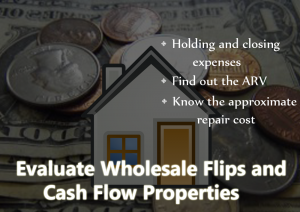Evaluating wholesale flips and cash flow properties is no cakewalk!
The key to success, when it comes to real estate is, knowing how to evaluate a deal. This article is going to reveal the crucial factors and strategies that experienced investors, realtors and appraisers use, so, now even you can master the skill of evaluating wholesale flips and cash flow properties.
Evaluation of Wholesale flips
- Find out the ARV:
After repaired value (ARV), finding the value of the property after the repairs and upgrades is the number one step in the deal evaluation process. Calculate the amount that people are ready to pay and then determine the other expenses, together with this find out the most advantageous place to initiate in order to make a decent profit.
To know the accurate ARV, you will have to look at the comparables, i.e. houses similar to your property in the same area that is recently sold or the ones that are up for sale. With this, you can settle on the current rate for houses in your neighborhood. This is an ideal indication of what your house will sell for. In order to get access to this type of information, you can contact a commercial real estate agent or make use of free or paid service from real estate database management companies.
If you wanted to get the most detailed information about a property that is sold or up for sale when you will probably want access to the multiple listing service MLS. During the access of the Multiple Listing Service, you will also need to work with a real estate representative, or become an agent yourself, or work with somebody who can get you access to the MLS. When you are done with all this, start it out with the MLS looking for refurbished sold comparables that are quite similar to your home.
In the next step, based on the number of “standard” sold comps you come across, you may also want to take into consideration other lately sold comps, which entails short sales or bank-owned properties (REOs) which have been refurbished or are in good condition. Following this, you need to extend your investigation to comps which are up for sale.
Check tax records. Do not make use of comparables from a different city or district and do take into consideration swimming pools, garage size, and other enhancements so you can regulate your value accordingly. With all that said, consider current market trends and price fluctuations for signs on both the resale value of the property, as well as the best time of years to purchase or put up for sale. So, these are the things that you need to keep in mind when finding out your ARV.
- Know the approximate repair cost:
The next step is to know the estimate of repair costs. With time and experience, you will be able to estimate repair costs without ever seeing the house and all that it takes is the age and size of the house. As another option, you can make use of some tools available online which will provide a list of the estimated costs to upgrade or replace the major systems and components in a typical home.
However, costs may vary depending on the region, upgrades, and complexity. If you choose to do the rehabbing work yourself, it’s well and good, on the other hand, if you are looking to “wholesale” the property to another investor, then all that you have to do is just contact them and, if they are a skilled rehabber, then you just have to pay you a fee and buy the house without you having to even take up the concept of rehabbing and calculating the ballpark figure.
- Holding and closing expenses:
When calculating your offer on an investment property, you need to be aware of the holding and closing expenses.
How to spot cash-flow properties?
Cash flow being the base of any successful investment strategy; it is this factor that tells you, whether your investment makes any financially viable sense. When it comes to evaluating positive cash flow of a property, it is vital that you analyze the geographical conditions and to target positive cash flow properties you need to work strategically and should look into high yielding suburbs in addition.
So now that you are clear about how to determine a property’s ARV, repair costs, what to expect from holding costs and closing costs together with some great formulas that will help you calculate your offers, its right time that you apply them in real life to make great offers and flip houses like a pro.
Despite that it might be a bit overwhelming at the start, but when you follow these things, you are sure to make a killer profit. Hope you found this article helpful, if you are interested in learning more about the key concepts of real estate to make quick cash and become a successful real estate professional, do join Zack Childress real estate seminars that will help you unearth the most strategic techniques of real estate.
See More: Properties in Wholesale Flips and Cash Flow


